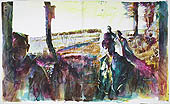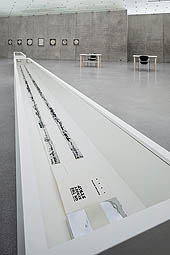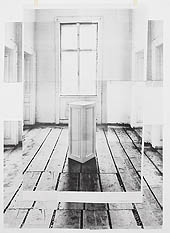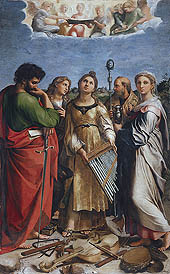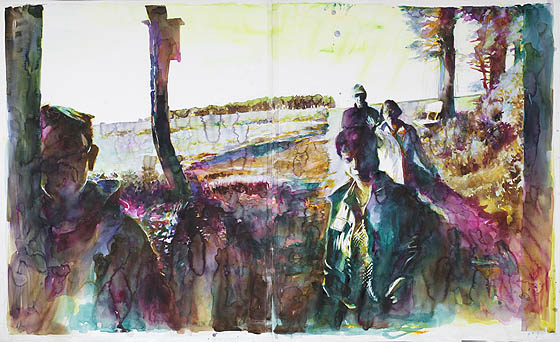
translated and summarized by: Liz Wollner-Grandville,
Einglish summaries July 2 - 15
Georg Kargl Fine Arts
Martin Damman – Blind Spot
29.06.12 – 8.09.12
by Gesche Heumann
In general, large format aquarelles are usually shown in Martin Dammann's exhibitions, but in the case of the titled "Blind Spot", it refers to an outstanding, short video in the rearmost room that creates an about-face in the exhibition's path. The film shows a bedroom into which a nice, older man enters, turns back the duvet carefully, pulls his trousers up over his knees to avoid bulges in the material and seats himself on the edge of the bed opposite the camera with a co-operative, friendly look on his face. One hears a man's voice enquiring whether the man (addressed as "Papa") can, as a matter of fact, remember why Philipp cried so often in bygone times – and "Papa" says in a friendly, but final, manner "no", gets up and goes out of the room (without smoothing the duvet). The whole thing takes 40 seconds and makes the violence, the insistence of the authority appear to have been correct - forgetting the dubious in a precise-laconic manner.
After this, the pictures seem different. The charm of the family album, which has evoked the previous scenes, vanishes. He who wants to have it really psycho, starts to pursue all the blind spots in the expressively depicted puddles of the water colours and sees himself confronted with anamorphosis and blurring (for example, "Slope" – how many persons lie buried in the slope?) which can give him the creeps. The sequence of five "Little dances" – pictures in which a male adult is practicing ballroom dancing with a child in a room – emerges as a cataclysm of the childish body through that of the adult's. The apparently somewhat cramped composition, "Jammertal ", in which the leading member of a group of hikers appears to have been pushed into a tree trunk on the left edge of the painting suddenly takes on a coercive character. A self-satisfied couple in the background dominates the picture – Dammann paints the figures with strident strokes in the light, while the two figures at the front wander towards the shadow. Highlighted in trenchant pink, the path drifts from a lightly sloping horizon into an overexposed, psychedelic atmosphere.
Martin Dammann sketches out his motifs with pencil. Based on the primary colours of the spectrum, the targeted contrast and shadow settings, the movement of the bodies, the way the folds of clothing fall and even the character of the spontaneously photographed model, appear confident and almost unconcerned. The change from sharp to blurred, the tension in the room through light and shade and the physical plasticity of the figures by means of the pools of colour are masterful.
Apparently no family cohesion can occur without a blind spot: something one can concentrate on excellently in front of Dammann's pictures.
Georg Kargl Fine Arts
1040 Vienna, Schleifmühlgasse 5
Tel: 01/585 41 99
Fax: 01/585 41 99-9
E-mail: office@georgkargl.com
www.georgkargl.com
Opening hours: Tue-Fri 11-19, Sat 11-16 hours
Kunsthaus Bregenz
Ed Ruscha – Reading Ed Ruscha
07.07. 12 – 14.10.12
By Wolfgang Ölz
The art superstar from the USA, Ed Ruscha, has, with the exhibition "Reading Ed Ruscha", presented a brilliant show of his creations from 1969 to the present. Some of the works presented have never been seen and come directly from the artist's studio to the Kunsthaus Bregenz.
The current exhibition has something of a dignified retrospective, in which the artist himself had a significant say. Around 120 works are shown. Director Yilmaz Dziewior said that three years ago, after Ed Ruscha had agreed to hold the exhibition, the latter also determined 95% of the exhibition's works. To this end, he invested in two years of intensive, creative work. A priceless commitment when one thinks that his works hang in all the most important collections in America, Europe and Asia, and even Barack Obama commissioned an Ed Ruscha for the White House.
The legendary art books are to be found on the first floor, whereby the Kunsthaus was able to gather all Ed Ruscha's books together. The books themselves are in glass cabinets but the visitor can skim through an iPad, thus accessing the contents. On the wall, 51 large-format framed pages from an art book by Jack Kerouac, "On the Road", can be seen. "Every Building on the sunset strip" shows the entire buildings on the "Sunset Strip" in Los Angeles, the domicile of the now 75-year old artist. Ed Ruscha's art is, above all, influenced by the great American art trends on the 60's and 70's: concept art and pop art.
The second floor shows pictures which exhibit horizontal stripes reminiscent of Mark Rothko or Barnett Newman, whereby Ed Ruscha appears to have driven out everything gestural in the stripes. Here, too, are pictures of landscapes onto which empty, horizontal stripes - wide enough to be able to accommodate a quote - have been pasted. In these book titles, which the visitor has to project onto the picture, deep maxims can be articulated, such as, for example, the sentence "Do as told or suffer". Large-format acrylic pictures, on which Ed Ruscha painted books, also catch the eye.
The third floor is the so-called "Belle Etage" of the Kunsthaus Bregenz, because it is substantially higher than the other two lower floors. For this final floor, Ed Ruscha created enormous formats depicting opened books. The whole has naturally something of an existential irony, the books are absolutely enormous but completely unusable because of being painted two-dimensionally. The whole tradition, the old story of humanity is presently displayed before our eyes but the present appears to be impossible to read.
Kunsthaus Bregenz
6900 Bregenz, Karl Tizian Platz
Tel: +43 5574 48 594-0
Fax: +43 5574 48 594-8
E-mail: kub@kunsthaus-bregenz.at
www.kunsthaus-bregenz.at
Opening hours: Tue - Sun 10-18, Thu 10-21 hours
Startgalerie in the MUSA
Evy Chytilek – Double U
29.06.12 – 30.08.12
By Wolfgang Pichler
The first work in the exhibition directly next to the entrance is representative for the general theme of the show – interiors and their design. That it actually refers to a very subtle and artistically challenging design and in no way refers to interior architecture in the real sense can be clearly deduced from the large-format, black and white pigment print. A room in a typical old Viennese building is shown that is apparently at the stage of either being demolished or is beginning to be renovated. It is doubled in the picture so that the limits of the rather small bedroom are pushed outwards. In the middle of the picture stands a podium apparently constructed out of old wood panelling which reinforces the impression of something larger and unfinished.
That the Vienna born (1981) artist understands how to deal with space and objects and how to process them to a very fine artistic work through minimal intervention can also be witnessed by the iron barrel hoops leaning against the wall in the corner. A harness of extremely thin filaments adds a minimal accent of colour. A transport crate made of rough chipboard is placed in the middle of the room and is turned into a sculpture by means of painting the individual chippings in different tones of grey.
It shows that there are fictitious or real spaces, which serve as point of reference and starting point for Chytilek's works, whereby one can understand her interventions as insinuations on architecture. That all design elements appear to be these "architecturally" found forms and materials fits well into the context of the exhibition.
Startgalerie in the MUSA
1010 Vienna, Felderstraße 6-8, next to the Town Hall
Tel: +43 (0)1 4000 8400
E-mail: musa@musa.at
www.musa.at/startgalerie
Opening hours: Tue, Wed, Fri: 11:00 - 18:00; Thu 11:00 - 20:00; Sat 11:00 - 16:00 hours
Museo Nacional del Prado
El ultimo Rafael
12.06.2012 – 16.09.2012
By Clementine Klügler
Apart from Leonardo, Michelangelo, and Titian, Raphael belongs to the stars of the Italian Renaissance. When the master from Urbino died in 1520 aged only 37 years, he left an extensive collection whose culmination occurred in Rome under the aegis of the art-appreciating Pope, Leo X. Then as now, the original was coveted. Per la mano di maestro was highly prized and desired by the commissioner when he could afford it.
Raphael created and painted large-format altarpieces and portraits for popes and cardinals, prepared frescoes for the Vatican, was responsible for sketching the blueprints of tapestries for the Sistine Chapel, was construction supervisor of St. Peter's cathedral and conservationist for antique monuments and archaeological excavations in Rome. It would not have been possible to have coped with the many facets and the flood of orders without a well-organized workshop.
Vasari attested that Raphael had up to 50 helpers – that was the largest workshop of the times. Then what is an original? In Raphael's case, the majority of the works are collective efforts. And that's what the exhibition in the Prado is all about – about the roles of his most important pupils, Gianfrancesco Penni and Giulio Romano – and also about the proof, based on the drawings and blueprints, of how much the master himself determined the construction and questions of detail in each work.
Penni and Romano play a significant role. Following Raphael's early death, both inherited the materials, orders and unfinished pictures. Giulio Romano was almost like a son to the master as can be seen from the pupil's famous "Self-portrait with a Friend". Both painters designed their own paintings in parallel in the workshop but their names only became known after Raphael's death.
The Prado and the Louvre are the museums that own the majority of Raphael's pictures. They have worked sequentially to accomplish the shows, and the completed works of his pupils up to 1525, during the past year. In addition, loans from all over the world have been added: altogether, 74 pictures and drawings, albeit only from the years 1513 to 1525.
Some of the most beautiful works have been gathered, from the madonnas and altarpieces to the portraits and the large-format "Transfiguration of Jesus". For the first time, Bologna has lent the "Holy Cecilia" (Pinacoteca Nazionale). She hangs right beside the "Madonna with the Fish" and the restored "Fall on the Road to Calvary" (both Prado). Heroic, the "Holy Michael" (Louvre) interacts in the great portrayals. Some attributions may be questionable for the observer. Often, only the main figure comes from Raphael's hand; occasionally, it's the blueprint alone, which is dated by the master ("John the Baptist", Uffizi). Giulio Romano's sovereignty is singled out in its own room.
Influences of the contemporaries can be felt and are fully indexed in the extensive catalogue: Leonardo da Vinci, Albrecht Dürer and Lucas von Leyden, Hieronymus Bosch, Michelangelo, and Titian.
The highlight is without doubt the portraits. Here are commissions, possibly again cardinals and patrons painted by Giulio Romano ("Bernardo Dovizi da Bibbiena" from the Pitti Palace and "Giuliano de Medici" from the Metropolitan Museum), besides private portraits of friends of Raphael: Baldassare Castiglione (Louvre), the lascivious banker, Bindo Altoviti (Washington, National Gallery) and above all, the famous "Self-Portrait with Giulio Romano" from the Louvre, which portrays a somewhat exhausted Raphael.
As Tom Henry and Paul Joannides, the curators of the exhibition, note in the catalogue, out of all the contemporary creators Raphael took the creative lead: "Raphael was not a lone genius".
Museo Nacional del Prado
28014 Madrid, Paseo Prado
Tel: +34 91 330 28 00
E-mail: museo.nacional@museodelprado.es
www.museodelprado.es
Opening times: Mon-Sat 10-20 hours, Sun and public holidays 10-19 hours
Mehr Texte von translated and summarized by: Liz Wollner-Grandville


 Teilen
Teilen

